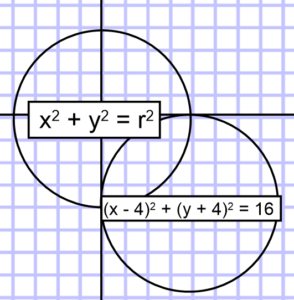“Trust in the Lord with all your heart and lean not on your own understanding; in all your ways submit to Him, and He will make your paths straight.” Proverbs 3:5 – 6
In the hustle and bustle of today’s world, it’s all too easy to find ourselves pulled in multiple directions, our attention fragmented by a constant stream of distractions. It’s as if we are constantly in search of our center, a point of balance that seems increasingly elusive. In the realm of mathematics, there’s a concept known as the parent graph, which serves as the foundation for various functions and equations. This parent graph is centered precisely at the origin of the graph, serving as its focal point. In our lives, just like in math, we need a center, that center is God.
Picture a simple circle on a graph with its center point at (0, 0). This circle is centered at the origin, undistracted by circumstances. But life is seldom as straightforward as mathematics. Distractions, challenges, and temptations continually enter our lives, shifting our center of focus away from where it should be: God. Our lives can easily be compared to that circle on the graph, where external factors pull our center of attention in different directions.

When our center shifts from God to worldly distractions, we start to feel adrift, lost in the chaos of life. The more we allow these distractions to consume us, the farther we drift from God. It’s a pattern familiar to many, as the pressures of daily life, ambitions, and desires lure us away from what truly matters.
But here’s the key: just as in mathematics, where we can recalibrate our graphs and equations to return them to the origin, God has the power to reset our focus and realign our lives with Him at the center. It’s a conscious choice to eliminate the distractions that have crept in and to reevaluate our priorities.
Returning to God as our central focus isn’t about ignoring our circumstances or situations. It’s about viewing them through a different lens, one that acknowledges His presence and guidance in our lives. When God is our center, we gain clarity of purpose, a sense of peace, and resilience in the face of life’s challenges. We become less swayed by the ever-changing currents of the world and more anchored in our faith.
The journey back to God as our focus is a personal and ongoing one. It involves regular self-examination, prayer, and reflection. It means making choices that prioritize our spiritual well-being and nurture our relationship with God. It’s about recognizing that the distractions and temptations of the world will always be there but understanding that we have the power to choose where we anchor our focus.
In a world filled with endless distractions, it’s crucial to pause and ask yourself: “Where is my focus?” Is it on the fleeting pleasures and worries of the world, or is it on something greater, something eternal? Much like recalibrating a graph to its origin, shifting our focus back to God can bring clarity, purpose, and a deep sense of fulfillment to our lives. It’s a choice worth making, for in God, we find our true center, our unwavering focal point amidst the chaos of life.










